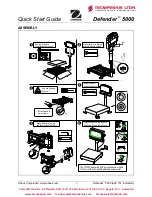
18
Ⅵ
. The detail about RS232:
1. RS-232 connects between scale and Host:
Scale -----------------------Cable---------------------------Host
(DB9 female)--------(DB9 male)----(DB9 female)--------(DB9 male)
TXD 2 --------------- 2 ------------------------ 2 --------------2 RXD
RXD 3 --------------- 3 ------------------------ 3 --------------3 TXD
GND 5 --------------- 5 ------------------------ 5 --------------5 GND
DSR 4 --------------- 4 ------------------------- 4 --------------4 DTR
DTR 6 --------------- 6 ------------------------- 6 --------------6 DSR
CTS 7 --------------- 7 -------------------------- 7 --------------7 RTS
RTS 8 --------------- 8 -------------------------- 8 --------------8 CTS
NC 1 -------------- 1 -------------------------- 1 --------------1
NC 9 -------------- 9 -------------------------- 9 --------------9
Note: The indicator DB9 female’s pin4 and pin6 is shorted, pin7 and pin8 is
shorted!
2.When P4 is set to 7: the protocol of RS232 is compatible to with NCI-SP1,
here is the details:
2.1) The baud rate and data format is fixed as per P5 and P6 setting. Responses to
serial commands will be immediate, or within one weight measure cycle of
the scale. One second should be more than adequate for use as a time-out
value by remote (controlling) device.
2.2) The length of the weight field will be 7 digit weight data, one for minus sign,
one for decimal point, two for measure unit (e.g. “lb”, “kg”). If the unit is
lb:oz, another two for “lb” and one for a space (<sp>) after lb. Units of
measure abbreviations are always lower case.
a) If the weight is overcapacity, the scale will return nine ‘^’ characters (the field
of minus sign, decimal point, weight data is filled by ‘^’).
If the weight is under capacity, it will return nine ‘_’ characters (the field of
minus sign, decimal point, and weight data is filled by ‘_’).
If the zero point is error, it will return nine ‘_’ characters.
b) The character will be ‘-’ for negative weight or a space character for positive
19
weight. Minus sign follows after the first digit.
c) Useless leading zero before digits is suppressed.
2.3) Key to symbols used
<LF> Line Feed character (hex 0AH)
<CR> Carriage Return character (hex 0DH)
<ETX> End of Text character (hex 03)
<SP> Space (hex 20H)
H1H2H3 Three status bytes
<p> Polarity character including minus sign for negative weight and a pace
character for positive weight
W1-W7 weight data
<dp> decimal point
U1U2: measure units, kg, lb, or oz
2.4) Commands and response
(1) Command: W<CR> (57h 0dh)
Response:
①
<LF>^^^^^^^^^u1u2<CR><LF>H1H2H3<CR><ETX>---over capacity
②<L
F>________u1u2<CR><LF> H1H2H3 <CR><ETX>---under capacity
③
<LF>---------u1u2<CR><LF> H1H2H3<CR><ETX>---zero-point error
Note: If the weight unit is lb: oz, U1U2= oz in above item
①②③
.
④
<LF><p>w1w2w3w4w5w6<dp>w7u1u2<CR><LF>H1H2H3<CR><ETX>
---Scale is stable, and the current weight unit is kg or lb. With or without
decimal point and the position is as per the P9 setting and current unit.
⑤
<LF><p>w1w2w3w4w5lb<sp>w6w7<o><z><CR>H1H2H3<CR><ETX>
Or <LF><p>w1w2w3w4lb<sp> w5w6<dp>w7oz<CR>H1H2H3<CR><ETX>
----The current unit is lb: oz.
(2) Command: S<CR> (53h 0dh)
Response: <LF> H1H2H3<CR><ETX>
(3) Command: Z<CR> (5ah 0dh)
Response: Zero function is activated and it returns to current scale status. just
like pressing
ZERO/ON/OFF
button:
<LF> H1H2H3<CR><ETX>
If ZERO function cannot be activated, it will return to current scale status.




































